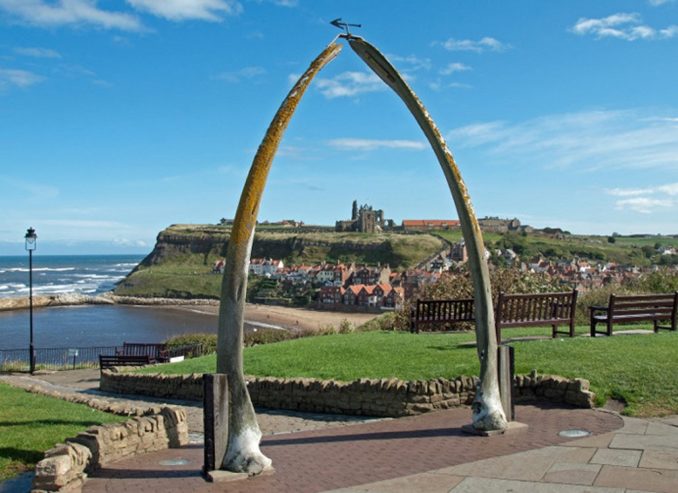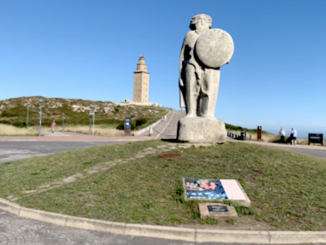
It always pleases me to know that Whitby comes from an Old Norse word: Hwitebi, which means ‘white settlement’. The name Whitby came into use around the 12th century, prior to that it is recorded as Streanæshealh it was the place where Oswy the Christian king of Northumbria, founded the first abbey, under the abbess Hilda. The Synod of Whitby which still governs when Easter occurs was held there in 664 AD.
Just for the record dear reader let me be clear that I do not condone whaling etc.
Many years ago I was on Scarborough Fish Pier talking to an old ex fisherman who had been taken on as one of the Lighthouse/pier men. It transpired that as a teenager he’d sailed on an old boat that had on its deck a boiler for processing whale blubber then by chance, because I was interested in the past, another old guy who was retiring from supplying commercial fishing gear gave me various whaling harpoons and equipment that had been in a back room since whaling days, I later gave them to the local fishing museum.
The banks of the Esk river running into the harbour and out to sea were in the past covered in Oak and other trees, ship building was located on the riverside, everything to hand for building then launching boats. Parkol Marine is there now still building but they are metal boats mostly for the Scots for prawning. Incidentally the woodwork of many of the old period houses in the town was done by ships carpenters when they were short of work and in places it’s quite obvious they were used to fitting out cabins.
In the 18th century, the whaling industry was a dominating presence in Whitby. Its history is marked now by the famous whalebone arch, the present jaws on the West Cliff were donated to the town by Alaska in 2003.
In 1790–91 Whitby built 11,754 tons of shipping, making it the third largest shipbuilder in England, after London and Newcastle. Taxes on imports entering the port raised money to improve and extend the town’s twin piers, improving the harbour and permitting further increases in trade.
After Alum processing at nearby Sandsend had brought prosperity to the area whaling started. The whaling boats set off with a crew of around fifty, with a compass hopefully but basically everything in the hands of the Ships Master. Captain Cook who is synonymous with Whitby is famous as an expeditionary but he actually started out as a whaler before becoming an explorer. His statue looks out to sea next to the whalebone arch.
Whaling was a dangerous business, the boats set off with a crew of between 40 and 50, they had longboats stowed on deck as when a whale was sighted these were lowered and the men rowed in pursuit of their catch. No depth sounders then, a plumb line would have been the only tool. Incidentally I can remember years ago a coble lost in thick fog (thick as guts being the local expression)off Scarborough, no radar of course and the skipper used a plumb line with fat on, when it came back up with soft black shale stuck on the end stuck to it he knew where they were in relation to the harbour.
Successful whaling boats returned to Whitby with the jawbones of their best catch hoisted on the lower spars and a garland at the mast. Most of the whale could be used. The tail would produce glue, the bones ground down to make manure. Bone from the whale’s mouth was used to create umbrellas or ornaments.
In 1753 the first whaling ship set sail to Greenland and by 1795 Whitby had become a major whaling port. The most successful year was 1814 when eight ships caught 172 whales, and the whaler Resolution produced a total of 230 tons of whale oil. The carcases yielded 42 tons of whale. Bone used used in the corsetry trade. Blubber was boiled to produce oil for use in lamps in four oil houses on the harbour side. The Resolution pub is on Flowergate, the name lives on.
Oil was used for street lighting until the spread of gas lighting reduced demand and the Whitby Whale Oil and Gas Company changed into the Whitby Coal and Gas Company. As the market for whale products fell, catches became too small to be economic and by 1831 only one whaling ship, the Phoenix, remained.
William Scoresby Snr and his son are not as well known as Cook but Scoresby Snr is credited with inventing or at least improving the “Crow’s Nest” a lookout platform high in the mast for spotting whales. Most of the geography of the Arctic was advanced by the whalers, the coast of Svalbard, East Greenland, was mapped by them, they were superb seamen.
Scoresby junior On 29 June 1816, commanding the Esk was on his fifteenth whaling voyage from Whitby when he encountered grave problems when ice damaged his ship. With the aid of his brother-in-law’s crew on board the John and after agreeing to surrendering much of their catch, the Esk was repaired, an account of which Scoresby gave in his 1820 book The Northern Whale-Fishery.
Between the crews they managed to bring the port side of the Esk onto the ice exposing the damage to starboard and repaired it. Absolutely heroic to do that and then sail home.
In 1991 ex seafarer Jack Lammiman who lived in Whitby and owned a boat named Helga Marie decided to make a voyage to the Arctic in homage to the great 18th century whaling skipper William Scoresby Snr and despite his vessel being deemed unseaworthy by inspectors. There was much press coverage of it at the time but he made it.
His crew of pensioners and a vicar braved stormy seas, repainted the vessel to disguise it from pursuing Royal Navy spotter planes – and braved an encounter with a polar bear. Later he was brought before the courts and fined £400. Now passed away he was a quiet man, I used to see him occasionally with his dogs while I was out myself dog walking. His exploit was later made into the film ‘Captain Jack’ the lead played by Bob Hoskins, much of it filmed in Whitby.
These are only a few paragraphs about our fascinating social history and the people, the museum in Pannett Park holds thousands of exhibits including much maritime history and is a mine of information for anyone interested.
© text & image Heavy Weather 2023



